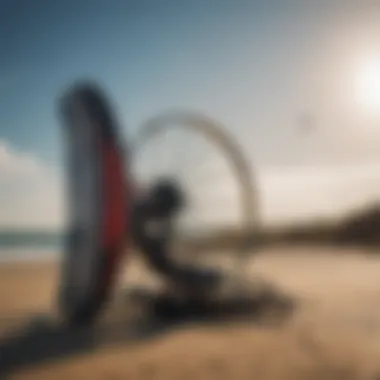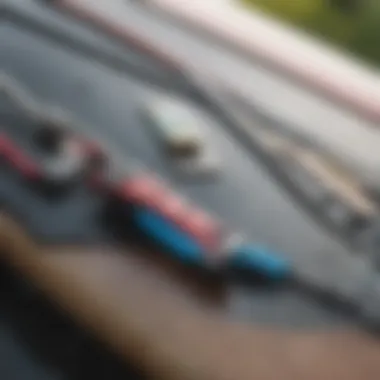Essential Guide to Kiteboarding Repair Kits


Intro
Kiteboarding is an exhilarating sport that surges with the rhythm of the wind and waves. This unpredictability, however, comes with its share of challenges, primarily around equipment maintenance. Falling into the routine of repairs might seem tedious, yet it's crucial. Knowing your gear inside and out can not only make or break your experience on the water but also keep you safe.
There’s an old saying that goes, "An ounce of prevention is worth a pound of cure." This couldn't ring truer for kiteboarders. Understanding the components of a kiteboarding repair kit will help gear enthusiasts tackle issues head-on, prolonging the life of their setups while maintaining peace of mind. This guide is tailored for everyone from a curious newcomer to a seasoned pro; it promises to enrich your journey, ensuring you stay afloat both literally and figuratively.
Equipment Insights
An adept kiteboarder knows that understanding their equipment is paramount. A keen insight into the tools and parts of a repair kit can save time and avoid costly mistakes, effectively turning unexpected challenges into minor inconveniences.
Essential Gear Maintenance
Maintaining your gear isn’t simply about patching up holes; it’s about being proactive. Regular inspections—checking for wear and tear, ensuring fasteners haven’t loosened, and confirming that the sail has not suffered any abrasions—are vital. To keep your kit in top shape, consider these tips:
- Visual Inspection: Check the kite and board for signs of damage regularly.
- Cleaning: Rinse your gear with freshwater after each session to eliminate sand and salt residues.
- Dry: Always dry your kite thoroughly to prevent mold and degradation.
An organized repair kit should contain:
- Patches and Adhesive: Essential for repairing any small tears or punctures.
- Leash: A backup in case your primary leash fails, which could save you from a swim back to shore.
- Tool Set: A simple set that includes screwdrivers and pliers to handle minor repairs on components.
"A well-maintained kiteboarding setup not only enhances performance but safeguards against unfortunate mishaps."
Technique Exploration
Having your equipment primed is just half the battle; mastering the right techniques is equally important. Whether it’s about improving your jumps or landing smoothly, understanding your maneuvers is fundamental to enjoying the sport more.
Beginner Techniques
For those just starting out, the basics can’t be overstated. Focus on foundational skills like returning to the shore gracefully after falls or managing your line tension during a launch.
Advanced Maneuvers
As you build confidence, delve into more complex maneuvers such as back loops or kite loops. These require not only courage but also a keen understanding of how your gear interacts with wind and water.
The nuances of kiteboarding, paired with a robust repair kit, can transform challenge into triumph. Proactivity will not only keep you on the water longer but will also deepen your connection with the sport.
Prolusion to Kiteboarding Repair Kits
Kiteboarding is not just a thrilling sport; it’s a commitment to adventure. You glide over water, feeling the wind tug at your board, but what happens when that ride doesn't go as planned? That's where having a solid kiteboarding repair kit comes into play. A good repair kit can act like a trusty sidekick, helping you maintain both safety and performance on the water.
When the sea calls, the last thing you want is to be side-lined because of a little hiccup in your gear. Missing that beautiful sunset session due to a minor leak or a worn line can be frustrating. The right repair kit ensures you're always ready for action, prolonging the life of your equipment, which can represent a significant investment for many kiteboarders.
Importance of a Repair Kit in Kiteboarding


Having a repair kit on hand not only safeguards your gear but can also save you from costly professional installations. It’s an essential tool that empowers you to handle minor repairs instantly. In many cases, a small tear in the fabric or a valve issue can be resolved on-site rather than waiting for repairs that may take days or weeks.
Imagine being out with friends, and someone’s kite develops a small hole. If they have a proper repair kit, they can get back in the air in no time, keeping the fun alive.
Moreover, a repair kit helps cultivate a mindset of preparedness. Should the unexpected arise, you can face the day with confidence. When the tide is in your favor and conditions are just right, don’t let equipment failures pull you off the wave.
Common Issues Faced by Kiteboarders
Kiteboarding, like many outdoor activities, comes with its fair share of challenges. Being aware of common issues can prepare you for what could happen:
- Bladder Leaks: Kit bladders are crucial for providing lift, and even the tiniest puncture can significantly affect performance.
- Material Tears: The canopy material can wear down over time, especially in areas subjected to wear and tear. Abrasions from sand or sharp objects can lead to rips.
- Line Damage: Kite lines are often exposed to harsh conditions and can fray or snap. Regular inspections are essential for safety.
- Valve Problems: Improper sealing or damage to valves can lead to air loss, compromising kite performance.
Recognizing these typical problems lays the groundwork for understanding the necessity of a comprehensive repair kit. By being proactive, kiteboarders ensure that they're not just equipped for the ride, but also prepared to address mishaps efficiently.
Essential Components of a Repair Kit
When it comes to kiteboarding, having a reliable repair kit can mean the difference between a sweltering day on the water and a ride that gets cut short due to equipment failure. The components of your repair kit serve to maximize the longevity of your gear and keep your escapades worry-free. They encompass everything from adhesives to tools, making it simpler to tackle unexpected issues that might arise while out riding the waves.
Types of Adhesives and Tapes
Adhesives and tapes are the backbone of any kiteboarding repair kit. Not just any glue will do; you need options specifically designed for the materials used in kite construction. Here’s a rundown of some effective choices you may want to consider:
- Tension Tape: This is particularly useful for quick fixes. It’s strong and waterproof, making it ideal for repairing minor tears in your canopy. Plus, it’s easy to apply, even in a pinch.
- PVC Adhesive: If you find your kite bladder with a leak, this adhesive works wonders. It can adhere to the bladder material securely, providing a reliable seal.
- Duct Tape: Though not the best choice for permanent fixes, it certainly has its place in a repair kit. Its versatility makes it suitable for temporary seals in both bladders and canopies.
In selecting adhesives, prioritize those that can withstand the elements. You don’t want your patches peeling off at the worst possible moment!
Patch Kits for Kite Bladders
Bladder leaks can be troublesome, but with the right patch kit, you can handle most incidents like a pro. Bladder patch kits come with specialized patches, usually made from the same material as the bladder. Here’s what you should know:
- Material Compatibility: Ensure the patch is compatible with your kite’s bladder material—typically PU or PVC. Using mismatched materials can lead to further problems.
- Patch Size: Many kits offer various patch sizes. Always opt for a larger patch if you��’re unsure it’ll cover the affected area completely.
- Application Instructions: Familiarize yourself with the application process; different kits may have varying instructions. Some may require roughening up the surface before application, while others may need a drying period.
Keep a patch kit handy. This allows you to address leaks on the spot rather than scrambling for a workaround.
Tools for Quick Repairs
You've settled on your adhesives and patches, but without the right tools, your repair efforts can quickly go south. Here are a few essential tools that should find a comfy home in your repair kit:
- Scissors: Sharp and precise, these are vital for trimming patches to fit.
- Ruler or Measuring Tape: Measurement is crucial to ensure your patches cover the necessary areas adequately.
- Screwdriver Set: Often, lines can get tangled or need replacing, and a set of screwdrivers will help with any hardware adjustments.
Having these tools at your fingertips allows you to facilitate repairs quickly. Remember, time lost is time you could have spent enjoying those perfect sea breezes.
Safety Gear for Repair Tasks
While it's easy to focus on the practical components of the repair itself, don’t forget about safety gear. Engaging in any repair work can present hazards, even if it’s something as seemingly simple as attaching a patch. Consider these items for your repair safety kit:


- Gloves: Protect your hands from adhesives and sharp edges. Nitrile gloves are sturdy enough to endure the rigors of repair tasks.
- Goggles: If you're using adhesives or working with materials that could lead to splinters, goggles can shield your eyes effectively.
- Masks: If you’re sensitive to fumes, a mask can help keep you safe from harmful vapors when using strong adhesives.
Choosing the Right Repair Kit
When navigating the waters of kiteboarding, the right repair kit serves as one of your most critical allies. Upon embarking on any trip, knowing that you have an adequate assortment of tools and materials can be the difference between turning back or soaring ahead. The truth is, mishaps happen, from a sudden gust of wind causing a minor tear to material fatigue wearing down a line over time. This section explores how to select a repair kit that meets your needs, keeping you safe and confident on the water.
Considerations for Beginners
For newcomers to kiteboarding, selecting a repair kit can feel daunting. However, it’s crucial to understand that this kit does not need to be a treasure trove of high-end equipment. Simplicity and functionality are key. Here are a few pointers for beginners:
- Essential Items: Your starter kit should include basic adhesive, a patch kit specific for bladder repairs, and a set of scissors. A utility knife can also come in handy. It’s better to have fewer yet essential items than to pack everything but lose track of what’s actually needed.
- Size and Portability: A good repair kit should fit comfortably into your bag without taking up too much space. Look for a compact kit made specifically for sports gear rather than bulky tools that may not be necessary in a pinch.
- User-Friendly Instructions: Make sure your kit comes with straightforward, easy-to-follow instructions. As a beginner, you'll want to minimize confusion, especially when dealing with urgent repairs on the water.
- Cost vs. Quality: Don’t fall into the trap of buying the cheapest kit on the shelf. While affordability is important, investing in a reliable kit can save you a headache later on. Generally, kits made by established brands, like Takoon or Slingshot, offer more dependable components.
"The first cut is the deepest; that goes for cuts to your kite as well. A good repair kit helps keep the stoke alive!"
Advanced Repair Kits for Professionals
For seasoned kiteboarders, the need is for a more sophisticated repair kit that can handle a broader range of issues. The last thing you’d want is to miss a session due to insufficient tools. Here’s what to look for:
- Expanded Tool Set: Beyond the basics, consider including specialized tools such as a valve wrench, a syringe for bladder inflation, and more robust scissors or multi-tools. Each of these adds versatility and efficacy when executing repairs right away.
- High-Quality Patches: Look for advanced patch kits that utilize heavier materials with superior adhesion properties. Brands like Airush offer specific materials designed to withstand harsher conditions that professionals often encounter.
- Detailed Repair Guides: An advanced kit should come with comprehensive guides that include advanced troubleshooting tips. It is beneficial to explore online communities or resources—like the kiteboarding forums on Reddit—where experienced boarders share their tailored advice and hacks.
- Customized Options: Some brands allow for custom kits to be built based on personal needs and preferences. This can be an ideal choice for those who already have a solid understanding of what repairs they anticipate needing.
- Stay Organized: Invest in a repair bag or case that compartments your tools adeptly. Being organized means you’ll spend less time digging through your kit and more time enjoying the sport.
Choosing the right repair kit tailored to your skill level can facilitate a smoother ride—literally and figuratively. Ensure that your kit reflects what you might need and keep it updated to match your growing experience and changing conditions.
Typical Repairs You Might Encounter
Kiteboarding is an exhilarating sport, but there’s no denying that it comes with its fair share of wear and tear. Understanding typical repairs is crucial for maintaining your kiteboarding gear's integrity and safety. It’s not just about getting back in the water quickly; knowing how to mend your equipment can ultimately prolong its lifespan and enhance your overall experience. Whether you’re a veteran rider or just starting out, a solid grasp on these repairs keeps you riding the waves rather than sitting on the sidelines, which can be quite a bummer.
Repairing Kite Bladder Leaks
Kite bladders are essential air chambers that provide structural support to your kite while in use. When faced with a leak, it can feel like the end of the world, especially when you're eager to hit the water. Repairing these leaks is a task every kiteboarder should know, as it restores your kite's functionality and prevents worse damage.
First things first, identifying where the leak originates can sometimes seem like searching for a needle in a haystack. A trick is to inflate the kite to a noticeable pressure and listen for that telltale hissing sound. Once located, clean the area thoroughly before applying a patch with appropriate adhesive. Make sure to press firmly and allow adequate time for curing.
Tip: Keep your bladder repair kit handy; having specific patch material designed for bladders can make all the difference in the durability of your patch.
Fixing Material Tears in Canopy
Tears in the canopy can also happen from sudden gusts of wind or snagging on obstacles—trust me, it’s more common than you think! These tears can lead to a loss of performance if not addressed promptly. In some cases, it could even spell the difference between a graceful landing and a messy crash.
For smaller tears, a simple patch applies just fine, but with larger rips, you’ll want to ensure your repair is robust. Using tear-specific tape, cut a patch that extends at least one inch beyond the tear itself. Is it starting to sound like you need some DIY skills? Don’t worry, just follow simple techniques.
"A well-mended canopy can make you feel like a brand new kite, ready to take on the skies once more."
Ensure that the patch is properly adhered and smooth out any bubbles or folds in the material. A quick inspection after a repair can help catch any potential issues before they become larger problems.


Line Damage Assessment and Replacement
Kite lines, perhaps the unsung heroes, bear the brunt of the rider's maneuvers and environmental conditions. Wind, water, and time can take a toll on their integrity. Therefore, assessing and replacing damaged lines is vital for both safety and performance.
Regularly inspect lines for signs of fraying or other wear. A simple visual check can go a long way—you might notice discoloration or thin spots along the line where it might have been rubbing against something. If you spot a damaged line, don’t ignore it. It can cause a malfunction during your ride, which no one wants.
To replace, first remove the damaged line carefully, then thread a new line through the same points. Secure it tightly, as a loose line can mean trouble later on. Consider double-checking your connections before your next outing to avoid unpleasant surprises. This little foresight can save you a major hassle and keep your kite in the sky where it belongs.
Best Practices for Using Repair Kits
When it comes to kiteboarding, having a repair kit at your disposal is just the tip of the iceberg. Using that kit effectively can make all the difference between an enjoyable day on the water and an unexpected trip back to shore. Implementing best practices not only enhances the longevity of your gear, but it also boosts your safety and confidence as you navigate the waves.
Regular Maintenance Checks
Regular maintenance checks are essential to ensure that everything in your repair kit is in tip-top shape. This isn’t just about inspecting your kite. It encompasses checking the tools, adhesives, and patch kits included in your kit as well. Over time, certain items can degrade, making them less effective when you actually need them.
- Inventorize Your Gear: Create a list of all items in your repair kit — from tools to adhesives. Check off what you have and what might be running low or expired.
- Inspect the Tools: Make sure each tool is functioning properly. A rusted blade or dulled scissors is a recipe for a failed repair. Replace any item that shows significant wear and tear.
- Test Your Adhesives: Before heading out, it can be wise to perform a quick test run of your adhesives. Apply a small blob on a scrap material and see if it holds. If it cracks or breaks easily, it’s time to buy a new one.
- Check for Updates: Sometimes, manufacturers release upgraded versions of products, or info on improved repair techniques. Stay in touch with kiteboarding communities or forums to keep abreast of any new developments.
These regular checks ensure that when disaster strikes—be it a damaged bladder or a busted line—you’re not left high and dry. The more you keep an eye on your kit, the better prepared you’ll be.
Storing Your Repair Kit Correctly
Proper storage of your repair kit is just as important as the items it contains. Just like a well-kept garden, a tidy and organized kit will flourish. Keeping your items in an appropriate environment not only prolongs their lifespan but also ensures you can find what you need when the moment arises.
- Choose a Dry Place: Avoid keeping your repair kit in damp or humid areas. Moisture can ruin adhesives and cause rust on tools. If possible, use a waterproof bag or container when transporting your kit.
- Keep it Organized: Use compartmentalized bags or organizers to separate the different tools and components. This saves time and stress when you're in a hurry to make repairs.
- Avoid Overstoring: Don't cram too much into one space. It can lead to a jumbled mess, making it harder to find what you need quickly.
- Label Everything: If you use boxes or bags, label each section clearly, so you can quickly get to the item you need without unnecessary fumbling. Being able to find your tools in a pinch can save you a boatload of hassle!
- You might have separate sections: one for tools, another for adhesives, and yet another for miscellaneous items like spare lines or patches.
Culmination
The significance of a comprehensive understanding of kiteboarding repair kits cannot be overstated. A properly stocked repair kit not only ensures the longevity of gear but also instills a sense of confidence in kiteboarders, allowing them to tackle unforeseen challenges without worry. This article highlighted how each component of the kit plays a pivotal role, from simple adhesive patches to more complex tools that enable the repair of various damages.
Additionally, maintaining your gear not only helps to keep your kite in good working order but also minimizes the chance of accidents on the water. Having a handy repair kit means that you can quickly address any potential hiccups, ensuring that your sessions remain enjoyable and safe. Consider it like carrying an insurance policy while out at sea; you might not always need it, but when you do, you will be grateful to have it at your disposal.
Recap of Repair Kit Importance
Every kiteboarder, regardless of skill level, should appreciate the vital role that a well-equipped repair kit plays in their sport. It serves as a first line of defense against damage that can occur due to rough conditions or equipment wear. This kit includes components like specialized tapes, adhesive patches, and essential tools that make all the difference between a good and a potentially hazardous day on the water.
Moreover, preparing for common repairs can save time and money. Ignoring the potential for gear failure can result in unnecessary expenses, not to mention lost time on the water. A prepared kiteboarder reduces risks substantially while improving overall safety.
Encouragement for Regular Preparation
Emphasizing the importance of preparedness in kiteboarding can’t be stressed enough. Regularly checking and maintaining your repair kit is not merely a suggestion; it's essential for safety and performance. The unpredictable nature of the wind and water means that kiteboarders are always at the mercy of the elements. Regularly reviewing your repair materials ensures that you are equipped to tackle minor issues before they escalate.
Incorporate routine checks into your maintenance schedule. Ensure that adhesives are not expired, and that ports for tools are stocked. Taking a few minutes at the end of each session can lead to more enjoyable experiences in the future.
"An ounce of prevention is worth a pound of cure."
It’s not just gear; it’s safety and reliability that every kiteboarder deserves. By taking the time to prepare, you set yourself up for success every time you hit the water.
Connect with fellow kiteboarding enthusiasts and share tips and experiences on platforms like Reddit or Facebook. Engaging in discussions can help you improve your repairs techniques and discover new tools or supplies you might not have considered.







